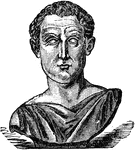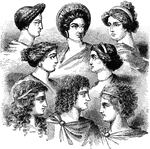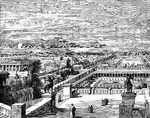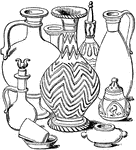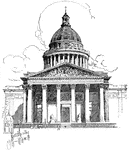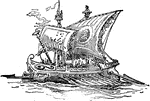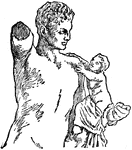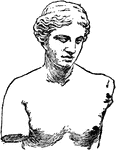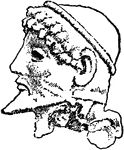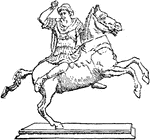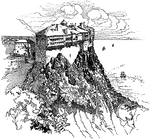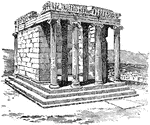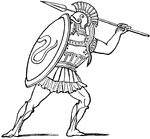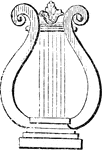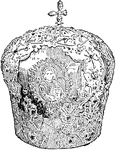
Decorated Greek Mitre
A decorated Greek mitre from the Orthodox Eastern Church. The hat is worn by the bishops. Greek mitre…

Mitre of Armenian Priest
"In the Armenian Church priests and archdeacons, as well as the bishops, wear a mitre. That of the bishops…
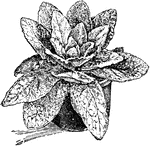
Verbascum Thapsus
Bears yellow toned flowers, used as funeral torches in early Greek and Roman society.

Procession of Bel
"The god Bel is generally known by his Greek name Belus. But the attributes given him by the Greek authors…

Battle of Cunaxa
Battle fought between two brothers, Cyrus the Younger and Arsaces. Cyrus managed to collect eleven thousand…
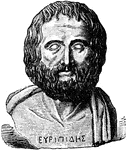
Euripides
"The next evolution is presented in Euripides. He is less ideal than his predeccesor, but truer to nature.…

Theater of Segesta
One of the first Greek amphitheaters, located in the political center of the Elymian people.

Aristophanes
A stature of Aristophanes, who was a prolific and commonly celebrated playwright of comedy. He is also…
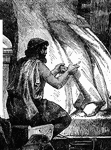
Phidias in His Study
"Phidias was the chief glory of the administration of Pericles. To him was committed the work of making…
!["Afterwards [Solon] went to Sardis and made the acquaintance of Cresus. It was on this occasion that the celebrated interview occurred which has been so much repeated for its lesson. Cresus, desiring to make an impression on his visitor, took him into his treasury and showed him his riches."—Ridpath, 1885](https://etc.usf.edu/clipart/78900/78916/78916_treasures_mth.gif)
Cresus Showing Solon His Treasures
"Afterwards [Solon] went to Sardis and made the acquaintance of Cresus. It was on this occasion that…

Clisthenes in the Olympic Games
Clisthenes, also known as the Father of Athenian democracy, is depicted competing in a chariot race…
!["The first noted public appearance of [Alcibiades] was on the occasion of the coming of the Lacedaemonian ambassadors requesting the surrender of Pylus. He at first violently opposed the petition, and even went so far as to urge the sending of an embassy to Argos to solicit that city to become a member in a new Athenian league. In spite of the earnest efforts of Nicias and of the protests of the Spartan ambassador, Alcibiades, by means of intrigue and bluster, succeeded in this work, and not only Argos, but also Elis and Mantinea, agreed to maintain an alliance with Athens for a hundred years."—Ridpath, 1885](https://etc.usf.edu/clipart/78900/78918/78918_alcibiades_mth.gif)
Alcibiades
"The first noted public appearance of [Alcibiades] was on the occasion of the coming of the Lacedaemonian…
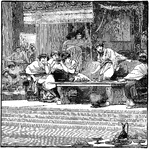
Banquet of Damocles
Image depicting a mythical moral anecdote, consisting of two morals. The first that regardless of who…
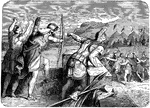
Astor to Philip's Right Eye
"It was during the siege of Methone that Philip had the misfortune to lose on of his eyes. A random…

The Isthmian Games
One of the Panhellenic Games of Ancient Greece. They were held both the year before and the year after…

Colossus at Rhodes
Statue of the Greek god Helios. It is currently considered to be one of the Seven Wonders of the Ancient…
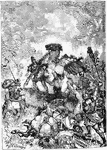
Death of Julian the Apostate
A depiction of Julian the Apostate, a noted philosopher and Roman Emperor, and his death.

Socrates
A classical Greek philosopher. He has become known for his contribution to the field of ethics, and…

Eleutherios Venizelos
A popular Greek revolutionary and Prime Minister of Greece, serving from 1910 to 1920 and again from…

Greek Soldiers
"A group of Greek soldiers, drawn from sculptured figures in the temple pediment."—Gordy, 1912

The Discus Thrower
Also known as Discobolus. The Discus Thrower is a famous, ancient bronze statue that demonstrates a…

Apoxyomenos
An ancient sculpture representing an athlete using a strigil to scrape sweat and dust off his body.

Temple of Neptune
"Paestum, the Greek Poseidonia, was a colony of Sybaris. The malarial atmosphere of the place led to…
Greek Soldiers in Arms
"From a Greek vase of about the time of the battle of Marathon."—Webster, 1913

The Mound at Marathon
"Near the southern extremity of the plain of Marathon rises a conical mound, 30 feet high. it covers…

An Athenian Trireme
An ancient ship used by Greeks and Romans. The ship has three rows of oars on each side, with a man…
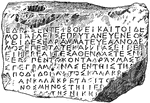
An Athenian Inscription
"A decree of the Council and Assembly dating from about 450 B.C."—Webster, 1913

Pnyx
"Shows the bema, or platform, from which orators addressed the assembled citizens."—Webster, 1913

Mourning Athena
"A tablet of Pentelic marble. Athena, leaning on her spear, is gazing with downcast head at a grave…
The Labarum
"The Labarum consisted of a staff or lance with a purple banner on a crossbar. It bore the two Greek…

An Athenian Gravestone
"A relief on the tomb of a certain Hegeso. It represents a woman, seated, taking a jewel from a casket…
Combat Between Achilles and Hector
A depiction of the mythological combat between Achilles and Hector.

Group of Gods and Goddesses
"The chief gods, in striking contrast with the monstrous divinities of the Oriental mythologies, had…
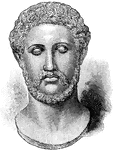
Alcibiades
A prominent Athenian statesman and member of the aristocratic family of the Alcmaeonidae.

The Dying Gaul
A Roman copy of an ancient Greek sculpture. The copy is made of marble, while the lost original sculpture…

Emblem of Ash'Toreth
An image of Ash'Toreth, or Ash'Taroth, who was called Astarte by the greeks. She was commonly known…

Gladiators
This illustration shows various types of gladiators, each type with with his specific weapons attributed…
